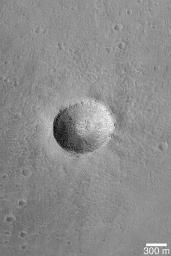
|
Impact on Arsia Mons
- Click the image above for a larger view
- Full-Res JPEG (540 x 810) (81.9 kB)
- Full-Res TIFF (540 x 810) (438.1 kB)
Caption:
MGS MOC Release No. MOC2-394, 17 June 2003
In planetary science, impact craters are "tools of the trade." They are common to all of the solid-surfaced objects in our Solar System, and are thus a good point of reference to compare different planetary bodies. This Mars Global Surveyor (MGS) Mars Orbiter Camera (MOC) image shows a crater that is about the same size as the famous Meteor Crater in northern Arizona, on the North American continent. This crater, however, is on the floor of the caldera--a large volcanic/collapse crater--of a giant martian volcano, Arsia Mons. This crater formed in volcanic rock, whereas the one in Arizona formed in sedimentary rock. Large, house-sized boulders dot the raised crater rim. This image is near 10.0°S, 120.4°W. The picture is illuminated from the left.
Cataloging Keywords:
| Name | Value | Additional Values |
|---|---|---|
| Target | Mars | |
| System | ||
| Target Type | Planet | |
| Mission | Mars Global Surveyor (MGS) | |
| Instrument Host | Mars Global Surveyor | |
| Host Type | Orbiter | |
| Instrument | Mars Orbiter Camera (MOC) | |
| Detector | ||
| Extra Keywords | Crater, Grayscale, Impact, Mountain, Volcano | |
| Acquisition Date | ||
| Release Date | 2003-06-19 | |
| Date in Caption | 2003-06-17 | |
| Image Credit | NASA/JPL/Malin Space Science Systems | |
| Source | photojournal.jpl.nasa.gov/catalog/PIA04581 | |
| Identifier | PIA04581 | |
